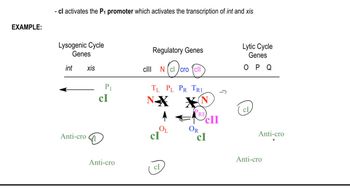Here are the essential concepts you must grasp in order to answer the question correctly.
Lytic and Lysogenic Cycles
The lytic and lysogenic cycles are two distinct pathways that bacteriophages, like λ phage, can follow after infecting a bacterial cell. In the lytic cycle, the phage replicates rapidly, leading to the destruction of the host cell and the release of new phage particles. In contrast, the lysogenic cycle involves the integration of the phage DNA into the host genome, allowing it to replicate along with the host cell without causing immediate harm.
Recommended video:
Decision Between Lytic and Lysogenic Cycles
cII Gene Function
The cII gene of λ phage plays a crucial role in determining the life cycle of the phage. It is involved in promoting the lysogenic cycle by stabilizing the expression of genes that lead to the integration of phage DNA into the host genome. When cII is active, it favors lysogeny; however, if cII is inactivated by mutations, the phage is more likely to enter the lytic cycle, as the regulatory balance shifts.
Recommended video:
Mutations and Gene Inactivation
Mutations are changes in the DNA sequence that can lead to the inactivation of genes, affecting their normal function. In the context of the cII gene, mutations that inactivate it would disrupt the regulatory mechanisms that favor lysogeny, potentially resulting in a higher propensity for the phage to undergo the lytic cycle. Understanding how specific mutations impact gene function is essential for predicting the behavior of phage strains.
Recommended video:
 Verified step by step guidance
Verified step by step guidance Verified video answer for a similar problem:
Verified video answer for a similar problem:



 4:29m
4:29m